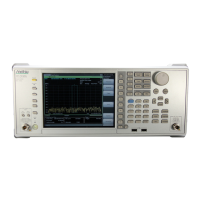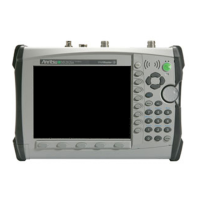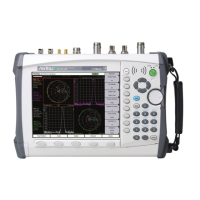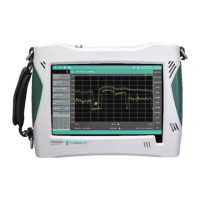Section 6 Talker Output Format
6-2
Note:
In this section, CNF? and SPF? are used to explain talker output formats. The MS9710C does not support
these commands.
Typical response messages are: measurement result, setting, and status information. Response messages are classi-
fied into those with header and those without header.
The following figure shows that messages, ASCII character strings with header, are sent from a device to a control-
ler in response to a center frequency message unit CNF? and a span frequency response message unit SPF?.
<NL>
<RESPONSE DATA>
123ØØØØØØ
Talker
(device)
Address 3
Listener
(controller)
CNF 123ØØØØØØ ; SPF 1ØØØØØØ <NL>
CNF 123ØØØØØØ
<RESPONSE MESSAGE>
<RESPONSE MESSAGE UNIT> <RESPONSE MESSAGE UNIT><RESPONSE MESSAGE UNIT SEPARATOR>
<RESPONSE MESSAGE TERMINATOR>
<TERMINATED RESPONSE MESSAGE>
SPF 1ØØØØØØ ;
<RESPONSE HEADER SEPARATOR>
sp
<character response data>
ØØØ1ØØØØØØ
<character response data>
123ØØØØØØ
<response mnemonic>
CNF
sp
<RESPONSE HEADER>
SPF
<RESPONSE HEADER SEPARATOR>
<RESPONSE DATA>
NL
<RESPONSE HEADER>
CNF
Only the operation-related parts is programmed as follows:
100 WRITE @103: “CNF? ; SPF?”! Center and span frequency query message
110 READ @103:A$! ← When a terminator NL is detected, a response message “CNF
123000000; SPF 1000000” is read into A$.
A response message is a sequence of functional elements, the minimum units that can represent functions, as is the
case with the program message. In the above figure, functional elements are indicated by uppercase characters with
them enclosed in < >. Functional elements are further classified into coding elements which are indicated by
lowercase characters with them enclosed in < >.
Let’s take a look at talker output formats focusing on the differences from listener input formats.

